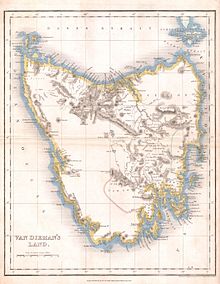Patriot War
[1] Participants in the conflict were members of a secret association known as the Hunter's Lodge, formed in the United States in sympathy with the 1837 Rebellions in Upper and Lower Canada.After a heavy bombardment by the British on Navy Island, where the republic had been established, Mackenzie and his force of Canadian militia retreated to Buffalo, New York, where they were captured by the U.S. Army.[3] The rebellion in Upper Canada ended with the Battle of Montgomery's Tavern and many of the rebels fled to the United States to escape arrest by British forces.[4] William Lyon Mackenzie spoke at a meeting in Buffalo that caused Thomas Jefferson Sutherland to commit to an invasion of Upper Canada to bring about their independence from Britain.During the month of December, large supportive meetings were held in towns along the border, including Burlington, Albany, Rochester, Buffalo, Cleveland and Detroit and aid was promised.[8] Allan MacNab and Andrew Drew of the Royal Navy crossed the international boundary and seized Caroline, chased off the crew, set her afire, and cast her adrift over Niagara Falls after killing a Black American named Amos Durfee.Handy and his brother-in-law Judge Orange Butler, then of the Michigan House of Representatives, joined G. M. Dufort of Montreal in travelling to Detroit where they formed a "war council" of influential citizens.On February 23 the steamboat Erie headed for Fighting Island, seven miles (11 km) south of Detroit, carrying more than 400 troops from Cleveland under General Donald McLeod.On February 22, General van Rensselaer and Daniel Heustis travelled to Hickory Island with less than 100 men to prevent arms from being seized under the Neutrality Act of 1794.[18] Twenty four men, largely Canadian, under the leadership of Colonel James Morreau assembled at Clark's Point near Lewiston, New York, on June 11, 1838 and crossed over the Niagara River.[20] After the failure of earlier efforts, in which US authorities had intervened, he organized lodges of the "Secret Order of the Sons of Liberty" along both sides of the Michigan border with Upper Canada.Early in the summer, Donald McLeod, a rebel Upper Canadian schoolmaster, and newspaper editor, was initiated in the "Brother Hunters" and informed them of the existence of Henry S. Handy's "Secret Order of the Sons of Liberty".They appointed a provisional Canadian republican government that included: The Hunters Lodges in both the Eastern and Western Divisions agreed that they would launch a general invasion of the Canadas on November 1.The Western division, under the general command of the "vice-president of the provisional government" of the Republic of Canada, Col. Nathan Williams of Cleveland, planned an attack at Detroit.However, "Major General" John Ward Birge convinced the eastern New York lodges to join him in an attack at Prescott, on the St Lawrence River instead.[25] The final planned Hunter attack was the western assault, organized out of Cleveland, on Windsor, which had as its intention U.S. invaders driving inland to London, Upper Canada.The guardhouse was destroyed by flames and the occupants taken prisoner, and Putnam's men continued on to Windsor where they set fire to the steamer Thames in retaliation for the destruction of Caroline.At 1:30 pm, a company of British regulars from the 34th (Cumberland) Regiment of Foot with a six-pound cannon and 20 mounted Aboriginals arrived at Sandwich and continued north to Windsor.[31] In geopolitical terms, the Rebellions and the Patriot War altered the landscape of relations between Britain and British colonial authorities, on one hand, and the American government on the other.[32] The extended series of incidents comprising the Patriot War were finally settled by U.S. Secretary of State Daniel Webster and Alexander Baring, 1st Baron Ashburton, in the course of their negotiations leading to the Webster–Ashburton Treaty of 1842.

Lower Canada RebellionPatriot War (Florida)Rebellions of 1837–1838Upper Canada RebellionBattle of the WindmillNavy IslandLower CanadaProvince of CanadaBritish EmpireUpper CanadaUnited StatesRepublic of CanadaHunters' LodgeHenry DundasAllan MacNabSheriffWilliam Botsford JarvisHugh BradyRobert NelsonCyrille-Hector-Octave CôtéCharles DuncombeWilliam Lyon MackenzieNils von SchoultzReform movementMontgomery's TavernSamuel LountJesse LloydPeter MatthewsAnthony Van EgmondCaroline affairWindsorPelee IslandShort HillsWindmillHunters' LodgesAbram D. SmithBill JohnstonCanada–United States borderBritishHunter's Lodge1837 Rebellions in Upper and Lower CanadaVermontFrères chasseursmilitiaBuffalo, New YorkU.S. ArmyWhiskey RebellionBattle of Montgomery's TavernGeorge TattersallDuncombeLondonBurlingtonAlbanyRochesterClevelandDetroitRoyal NavyNiagara FallsTorontoMichigan House of RepresentativesMontrealIllinoisKentuckyU.S. marshalFort MaldenBois Blanc IslandbeachedQuebec CityStevens T. MasonBattle of WindsorFighting IslandHickory IslandNeutrality Act of 1794KingstonBattle of Pelee IslandSandusky BayLake ErieNeutrality Lawsattack on TorontoShort Hills RaidLewiston, New YorkBenjamin WaitUnited States Army Corps of Engineerscommissioned officersfield officersA.D. SmithPrescottSt Lawrence RiverNils Szoltevsky Von SchoultzSackets Harbor, New YorkOgdensburgJohn A. MacdonaldPort HuronSarnia34th (Cumberland) Regiment of FootDaniel WebsterAlexander BaringWebster–Ashburton Treatytransported to AustraliaHMS BuffaloHobartVan Diemen's LandConcordAustraliaLyme, New YorkIllawarraNew South WalesCircular HeadTasmaniaSalinaOnondaga CountyNew YorkMartin Van BurenfilibustersAlexander Baring, 1st Baron AshburtonFort WayneFenian raidsWayback MachineThe Detroit Evening NewsInternational History ReviewKilbourn, William